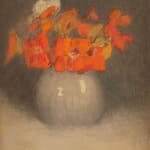Henry Bayley Snell 1858-1943
Still Life of Red Geraniums
Watercolor and pastel on board
12 1/4 x 9 1/4 inches
31.1 x 23.5 cm
Framed dimensions: 19 x 16 inches
31.1 x 23.5 cm
Framed dimensions: 19 x 16 inches
Signed lower right: Henry B. Snell
Born in Richmond, England, on September 29, 1858, Henry Bayley Snell was the son of Edward and Elizabeth Snell. At the age of seventeen Henry immigrated to the United States...
Born in Richmond, England, on September 29, 1858, Henry Bayley Snell was the son of Edward and Elizabeth Snell. At the age of seventeen Henry immigrated to the United States and studied painting at the Art Students League in New York. In 1888 he married the artist Florence Francis, who was also a native of England.
In the early 1880s Snell worked for a printing and etching house called the Photoengraving Company, where he met another aspiring young artist, William L. Lathrop. The two quickly became friends, and in the mid-1880s spent several weeks sailing and painting on Lake Erie near Lathrop's ancestral home in Painesville, Ohio. They also traveled to England together in 1888. The Snells' first visit to Bucks County may have been as early as 1898, when Lathrop made his first visit to the area. Henry and Florence spent many Sunday afternoons at the Lathrop home at Phillips Mill. Around 1925 the Snells settled permanently in New Hope, where they rented the top floor of the Solebury Bank building at the corner of Bridge and Main.
The Philadelphia School of Design for Women (now the Moore College of Art and Design) in Philadelphia offered Snell a teaching position in 1899, which he accepted, remaining on the faculty until his death in 1943. Considered the most influential teacher on the staff, Snell taught many of the women who would eventually form the group called the Philadelphia Ten. Frequently returning to his native England to paint, especially to the artist colony at St. Ives on the coast of Cornwall, Snell often took along students from his classes. He was well known for marine scenes as well as landscapes painted around New Hope, particularly from his apartment. He taught in the summers at Gloucester, Massachusetts (1916-1920), and at Boothbay Harbor, Maine (1921-1927).
Snell was named assistant director of fine arts for the U.S. Commission to the Paris Exposition of 1900, and was elected to the National Academy of Design in 1906. He also served as president of the New York Water Color Club. Snell continued to participate and win prizes in many of the major exhibition events of the early 1900s, including the Panama-Pacific International Exposition of 1915 in San Francisco, where he was awarded both gold and silver medals.
Provenance
Private collectionPlease join our mailing list
* denotes required fields
We will process the personal data you have supplied in accordance with our privacy policy (available on request). You can unsubscribe or change your preferences at any time by clicking the link in our emails.



